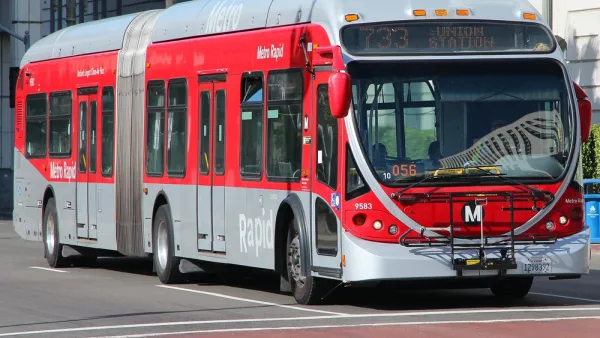Op-ed: Charging road users by how much they drive, not how much gas they buy, is the only sustainable way forward for infrastructure funding.

Earlier this year, President Biden called for electrifying the entire federal vehicle fleet — about 645,000 passenger cars, trucks and vans — putting the nation on track to a green energy transportation future.
General Motors followed shortly after, announcing plans to only produce all-electric vehicles (EVs) by 2035. Several other major automakers either plan to or have already produced EV models, joining Tesla, which has dominated the market for over a decade.
That’s the good news. The bad news? We need to find a way to pay for the repair and maintenance of our roads, bridges and public transit—which all rely in part on gas tax revenues—once we fully transition away from gas-powered vehicles.
Demand for EVs in the U.S. is expected to grow, accounting for a projected 7.6 percent of the passenger car market in 2026, up from just 1.2 percent in 2018. While new EVs are more expensive than conventional vehicles, prices will fall as they become less costly to produce. Federal and state governments also offer a range of consumer incentives such as tax credits, cash rebates and reduced registration fees to boost sales.
In addition to becoming more affordable to purchase, demand for EVs is certain to rise further as drivers become more aware of the money they could save on fuel and routine maintenance.
The growing demand for EVs and U.S. automakers’ production decisions may also reflect a shift in attitude on climate change among Americans. A Pew poll last year found that almost two-thirds of Americans said that protecting the environment should be a priority for the federal government compared to 41 percent in 2008. EV adoption will go a long way towards reducing environmentally harmful carbon emissions, as transportation accounts for almost a third of total emissions, the largest share of any economic sector in the U.S.
But as more drivers ditch their combustion engine cars for the electric equivalent, concerns are rising that revenues in the Highway Trust Fund, a dedicated source of money from the federal gas tax charged at the pump, will further erode. Because the tax has not been raised since 1993 and fuel efficient vehicles have increased in popularity, there has been a growing gap between the money needed to maintain our roads and the amount raised through the Fund. Since 2008, Congress has had to rely on annual transfers from non-dedicated revenue sources to prevent the Highway Trust Fund from running out of money.
With the gas tax becoming more unreliable as a revenue source and EVs on the horizon, most experts now agree that something needs to be done: the question is, what?
FULL STORY: Gas Taxes Pay For Our Roads. What Happens When Cars Go Electric?

National Parks Layoffs Will Cause Communities to Lose Billions
Thousands of essential park workers were laid off this week, just before the busy spring break season.

Retro-silient?: America’s First “Eco-burb,” The Woodlands Turns 50
A master-planned community north of Houston offers lessons on green infrastructure and resilient design, but falls short of its founder’s lofty affordability and walkability goals.

Delivering for America Plan Will Downgrade Mail Service in at Least 49.5 Percent of Zip Codes
Republican and Democrat lawmakers criticize the plan for its disproportionate negative impact on rural communities.

Test News Post 1
This is a summary

Test News Headline 46
Test for the image on the front page.

Balancing Bombs and Butterflies: How the National Guard Protects a Rare Species
The National Guard at Fort Indiantown Gap uses GIS technology and land management strategies to balance military training with conservation efforts, ensuring the survival of the rare eastern regal fritillary butterfly.
Urban Design for Planners 1: Software Tools
This six-course series explores essential urban design concepts using open source software and equips planners with the tools they need to participate fully in the urban design process.
Planning for Universal Design
Learn the tools for implementing Universal Design in planning regulations.
EMC Planning Group, Inc.
Planetizen
Planetizen
Mpact (formerly Rail~Volution)
Great Falls Development Authority, Inc.
HUDs Office of Policy Development and Research
NYU Wagner Graduate School of Public Service




























